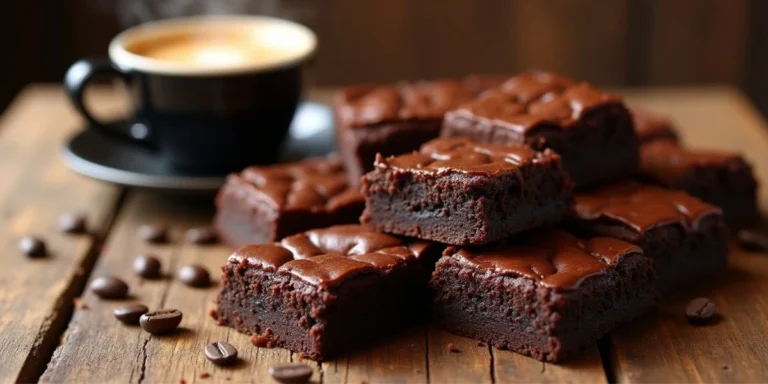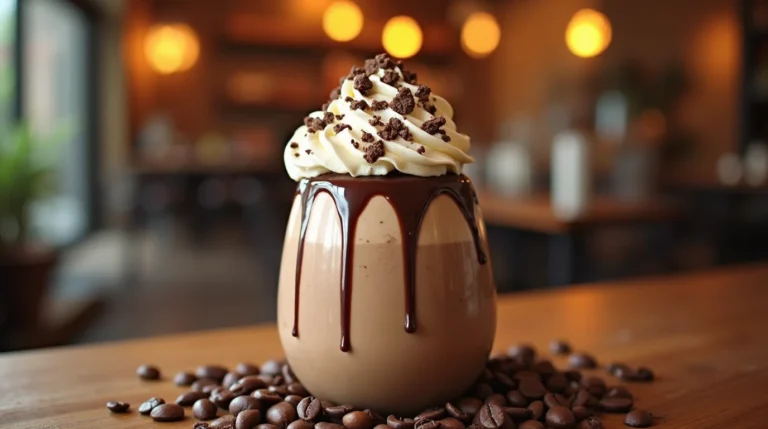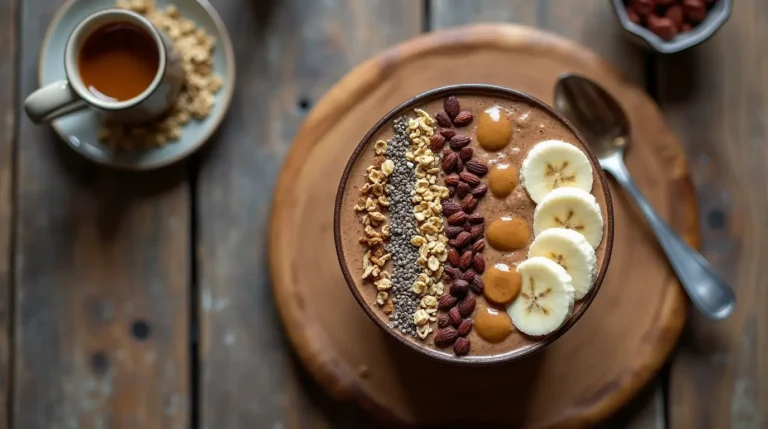How To Bake Perfect Coffee Macarons Every Time
There’s something undeniably elegant about macarons—but coffee macarons? They’re next-level. With their crisp shells, chewy centers, and rich espresso flavor, coffee macarons are the perfect fusion of dessert and caffeine indulgence. Whether you’re treating yourself or impressing guests, these little gems bring a luxurious café experience straight to your kitchen.
In this post, you’ll learn how to bake perfect coffee macarons every time, even if you’re new to the world of French baking. From the exact ingredients and tools you’ll need, to step-by-step guidance and pro tips, we’ve got you covered.
So if you’re a coffee lover, a baking enthusiast, or just someone looking to master the art of macarons—get ready to dive in and bake your new favorite treat!
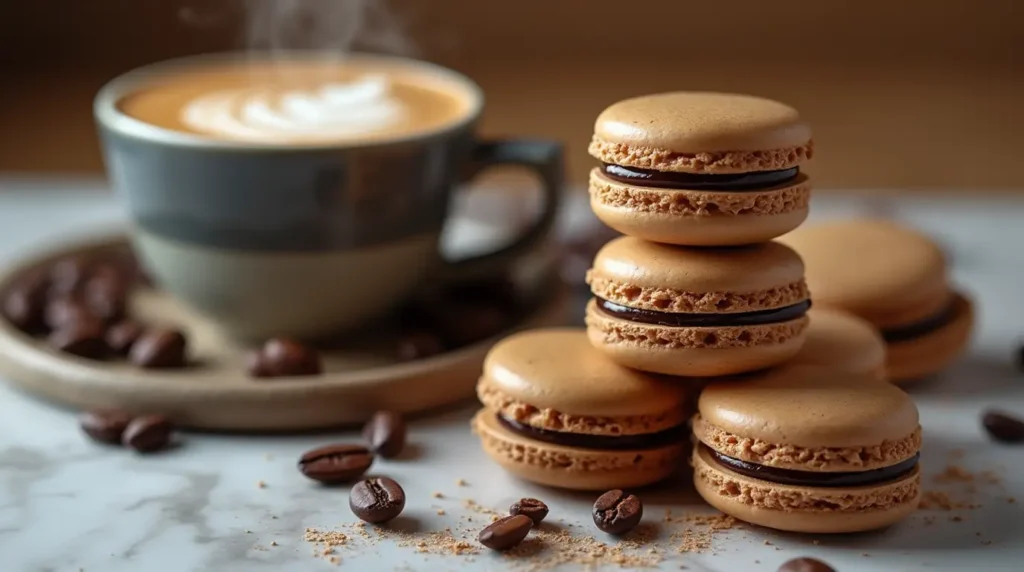
Essential Ingredients and Tools for Coffee Macarons
Key Ingredients Breakdown
To make perfect coffee macarons, selecting the right ingredients—and understanding their purpose—is essential. Each component contributes to the structure, flavor, or texture of the finished macaron. Here’s what you need and why:
Egg Whites
Egg whites form the foundation of the macaron shell. Beating them into a stiff meringue helps give macarons their signature rise and delicate texture. For best results, use aged egg whites—this means separating them and letting them sit uncovered in the refrigerator for 24 to 48 hours. This process reduces moisture content and results in a more stable meringue.
Almond Flour
Use blanched almond flour that is finely ground and sifted. The almond flour gives macarons their nutty flavor and chewy texture. Any lumps or coarse pieces can ruin the smooth finish of the shells, so always sift before mixing.
Powdered Sugar
Powdered sugar (also called confectioners’ sugar) is combined with the almond flour to form the dry base known as “tant pour tant.” It adds sweetness and helps with the smoothness of the shells.
Granulated Sugar
Granulated sugar is added gradually while whipping the egg whites to stabilize the meringue. It gives the meringue a glossy sheen and helps it hold its shape when folded into the batter.
Espresso Powder or Coffee Extract
To infuse the macarons with bold coffee flavor, espresso powder is ideal. It dissolves easily and integrates smoothly into the dry mixture. Alternatively, coffee extract or concentrated brewed espresso can be added to the buttercream filling for a more intense, aromatic coffee kick.
Buttercream Filling Ingredients
The filling adds richness and flavor contrast. A basic coffee buttercream is made from unsalted butter, powdered sugar, and brewed espresso or coffee extract. You can also add vanilla extract to round out the flavor.
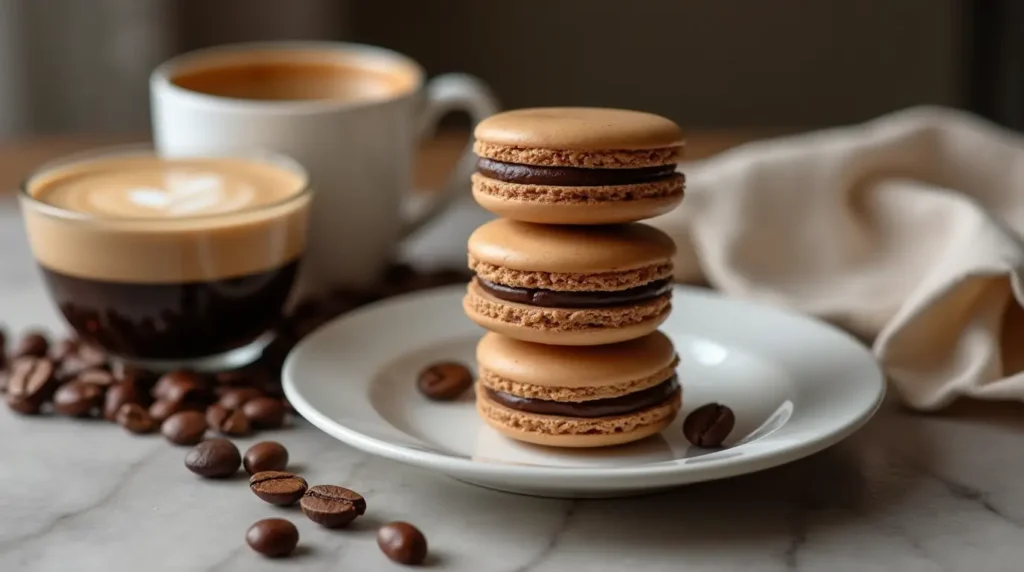
Ingredient Reference Table:
| Ingredient | Amount | Notes |
|---|---|---|
| Egg whites | 3 large | Aged at room temp for better stability |
| Almond flour | 1 cup | Finely ground and sifted |
| Powdered sugar | 1 ½ cups | Sifted to avoid lumps |
| Granulated sugar | ¾ cup | For stabilizing the meringue |
| Espresso powder | 1 tbsp | Adds rich coffee flavor |
| Coffee extract | 1 tsp | Optional for deeper flavor |
| Unsalted butter | ½ cup | Softened, for buttercream |
| Powdered sugar (filling) | 1 ½ cups | For the buttercream sweetness |
| Brewed espresso | 2 tbsp | For buttercream, cooled |
| Vanilla extract | 1 tsp | Optional, enhances overall flavor |
Recommended Tools for Success
Even with the right ingredients, macarons can be tricky without the proper tools. Here’s a list of essential baking tools that will help you get consistent, professional-quality results:
- Stand Mixer or Hand Mixer: Whipping the egg whites to stiff peaks is a critical step. A stand mixer like a KitchenAid makes this process easier and more reliable, but a quality hand mixer will also work.
- Silicone Baking Mat (Silpat): These non-stick mats help ensure even baking and prevent the shells from sticking. They also promote better heat distribution compared to parchment paper.
- Piping Bags with Round Tips: Accurate piping is key for evenly sized macarons. Use piping bags fitted with a round tip (such as Wilton #12) to create consistent rounds.
- Kitchen Scale: Precision is everything in macaron baking. Measuring by weight (instead of volume) ensures accuracy and consistency, especially when working with delicate ratios.
- Sifter or Fine Mesh Strainer: For almond flour and powdered sugar, a sifter helps eliminate clumps and ensures a silky-smooth batter.
- Oven Thermometer: Oven temperatures can vary, and macarons are very sensitive to heat. An oven thermometer helps ensure your oven is at the correct temperature for baking.
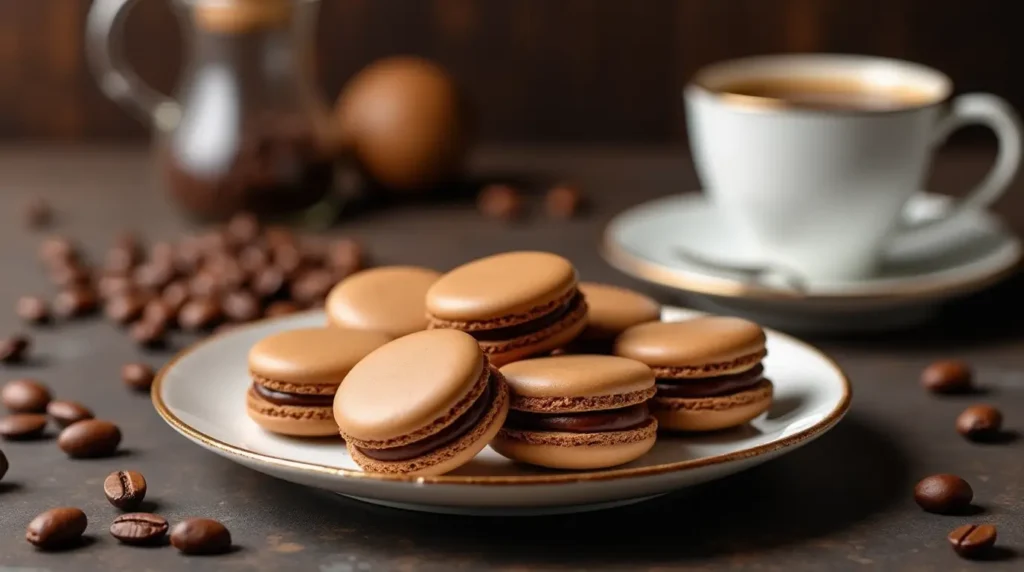
Choosing the Right Coffee Flavor
When making coffee macarons, choosing the best flavoring option will make a big difference in the final taste. Here’s how to decide what works best for you:
Espresso Powder vs Coffee Extract
- Espresso powder is the most commonly used flavoring for macaron shells. It’s dry, blends well with the almond flour and powdered sugar, and doesn’t alter the batter’s consistency.
- Coffee extract, on the other hand, is a liquid. It’s best used in small quantities or in the buttercream filling to prevent excess moisture from affecting the shell structure.
Flavor Intensity Matters
Want a strong coffee punch? Use both espresso powder in the shells and coffee extract or brewed espresso in the filling. For a subtler taste, stick to one or the other. Keep in mind that too much liquid can compromise texture, so balance is key.
Optional Flavor Pairings
Coffee pairs beautifully with other flavors that can elevate your macarons. Try incorporating:
- Chocolate: Add cocoa powder to the shells or use chocolate ganache filling.
- Hazelnut: Use hazelnut flour or a Nutella-based filling for a mocha-nutty twist.
- Vanilla: Add vanilla extract to the buttercream for a more rounded, aromatic profile.
Step-by-Step Process to Bake Perfect Coffee Macarons
Making macarons may seem intimidating at first, but by following a clear, step-by-step process, you can achieve beautifully smooth shells with iconic ruffled “feet” and just the right amount of chew. Below is a breakdown of each stage, so you can confidently create perfect coffee macarons at home.
Preparing the Macaron Shells
Before you begin, make sure all your tools are clean and dry. Any grease or moisture can prevent your meringue from forming properly.
1. Sift the Dry Ingredients
Start by sifting the almond flour, powdered sugar, and espresso powder together into a large mixing bowl. This helps remove any lumps and ensures a smooth, uniform batter. You can sift them together twice for an extra-fine result. Discard any coarse bits left in the sieve.
2. Make the French Meringue
In a separate, clean bowl, whip the aged egg whites using a stand mixer or hand mixer on medium speed until they become foamy. Gradually add the granulated sugar while continuing to beat. Increase the speed to high and continue mixing until stiff, glossy peaks form.
A good French meringue should hold its shape and create sharp peaks that don’t collapse.
3. Fold the Batter (Macaronage)
Add one-third of the dry mixture to the meringue and gently fold it in using a spatula. Continue adding the rest in batches. The goal is to fold the batter until it flows like lava—smooth and glossy, but not runny.
A good test is to lift your spatula and let the batter fall back into the bowl in a ribbon that slowly disappears into itself after 10–15 seconds.
Piping and Resting the Macarons
Once your batter reaches the right consistency, it’s time to pipe.
1. Use Templates for Uniform Size
Place macaron templates under a silicone baking mat or parchment paper. Fill a piping bag fitted with a round tip (like Wilton #12) and pipe 1.5-inch rounds, keeping the bag straight and perpendicular to the surface for even circles.
2. Tap the Trays
After piping, tap the baking sheets firmly on the counter 3–5 times to release any trapped air bubbles that could cause cracks. You can also use a toothpick to pop any remaining surface bubbles.
3. Rest the Shells
Let the macarons rest at room temperature for 30 to 60 minutes or until a dry skin forms on the surface. You should be able to gently touch them without batter sticking to your finger. This skin is essential for forming feet during baking.
Baking and Checking for Doneness
This step can make or break your macarons, so it’s important to get the temperature and timing just right.
1. Preheat and Monitor Oven Temperature
Set your oven to 300°F (150°C) and use an oven thermometer to ensure it’s accurate. Macarons are extremely sensitive to heat fluctuations, so consistency is key.
2. Bake Time and Signs of Success
Bake each tray for 14 to 16 minutes, rotating halfway through if your oven has hot spots. The macarons should develop classic ruffled “feet” and have firm, dry tops.
To test for doneness, gently touch the top of a macaron—if it doesn’t wiggle from the base, they’re ready.
3. Cool Before Removing
Let the macarons cool completely on the baking sheet before attempting to remove them. Trying to peel them off too early can cause sticking or tearing.
Tip List for Macaron Success
- Avoid over-mixing or under-mixing the batter—this is one of the most common causes of flat or cracked shells.
- Use an oven thermometer to ensure precise baking temperatures.
- Let the shells cool fully before removing from the mat to prevent breakage.
- If your macarons crack, flatten, or don’t develop feet, revisit the folding technique or resting time.
- Bake one tray at a time for the most consistent results.
Making and Filling with Coffee Buttercream
A rich, creamy buttercream filling is the perfect match for crisp, chewy coffee macaron shells. This section covers how to make a smooth and flavorful coffee buttercream, assemble the macarons with precision, and store them properly for optimal taste and texture.
Simple Coffee Buttercream Recipe
This buttercream is quick, easy, and full of bold coffee flavor. It pairs beautifully with the subtle bitterness of the espresso-infused macaron shells.
Steps:
- Cream the Butter
Start by beating softened unsalted butter with a hand mixer or stand mixer until it becomes light and fluffy. This usually takes 2–3 minutes on medium-high speed. - Add the Sugar Gradually
Slowly add the sifted powdered sugar while mixing on low speed to avoid splatter. Once incorporated, increase the speed and beat until smooth. - Incorporate the Coffee
Add brewed and cooled espresso or strong coffee a little at a time, beating well after each addition. If you want a bolder flavor, you can substitute or supplement with a small amount of coffee extract. - Add Vanilla Extract (Optional)
A splash of vanilla enhances the buttercream’s depth and balances the espresso flavor. - Adjust Consistency
If the buttercream is too thick, add a tiny bit of milk or cream. If it’s too loose, add more powdered sugar. Beat until the texture is airy and pipeable.
Coffee Buttercream Recipe Table:
| Ingredient | Amount | Notes |
|---|---|---|
| Unsalted butter | ½ cup | Softened to room temperature |
| Powdered sugar | 1 ½ cups | Sifted for a smooth texture |
| Brewed espresso/coffee | 2 tbsp | Cooled; can sub with extract |
| Vanilla extract | 1 tsp | Optional, enhances flavor depth |
Assembling the Macarons
Once your macaron shells have cooled completely and your buttercream is ready, it’s time to assemble your coffee macarons.
Step-by-Step Assembly:
- Pair the Shells
Match up your macaron shells by size and shape. This helps ensure a uniform look when the macarons are sandwiched. - Pipe the Buttercream
Fill a piping bag fitted with a round tip and pipe a small mound of buttercream onto the flat side of one shell. Start from the center and spiral out if needed—don’t overfill, as it will spread once sandwiched. - Sandwich the Macarons
Gently press a matching shell on top of the buttercream to form a sandwich. Twist slightly as you press to help seal the edges and evenly distribute the filling.
Maturing and Storing Macarons
Coffee macarons, like all classic French macarons, benefit greatly from a process called “maturing.” This allows the shells and filling to meld, creating a softer, more flavorful bite.
Maturing Process:
- Refrigerate for 24–48 hours: Once assembled, place the macarons in an airtight container and refrigerate them for at least one full day. During this time, the shells will absorb moisture from the buttercream, creating that ideal chewy interior.
- Let them sit at room temp before serving: Bring them out of the fridge about 30 minutes before eating. This allows the buttercream to soften and the flavors to fully develop.
Storage Tips:
- Shelf life: Properly stored macarons will last up to 5–7 days in the refrigerator.
- Freezing: You can freeze assembled macarons in an airtight container for up to 1 month. Thaw in the fridge overnight and bring to room temp before serving.
Conclusion
Mastering coffee macarons may take a little patience and precision, but the end result is a luxurious, café-style treat you can proudly share (or keep all to yourself!). Let’s recap a few key tips to ensure your baking success:
- Sift your dry ingredients thoroughly for smooth shells.
- Whip your meringue to stiff peaks and use proper macaronage technique.
- Let the shells rest before baking to develop that signature skin and feet.
- Use brewed espresso or coffee extract in your buttercream for a bold, rich flavor.
- Store your macarons properly to allow the flavors to mature and the texture to perfect.
Now it’s your turn! Put on your apron, whip up a batch, and enjoy the sweet satisfaction of homemade coffee macarons.


